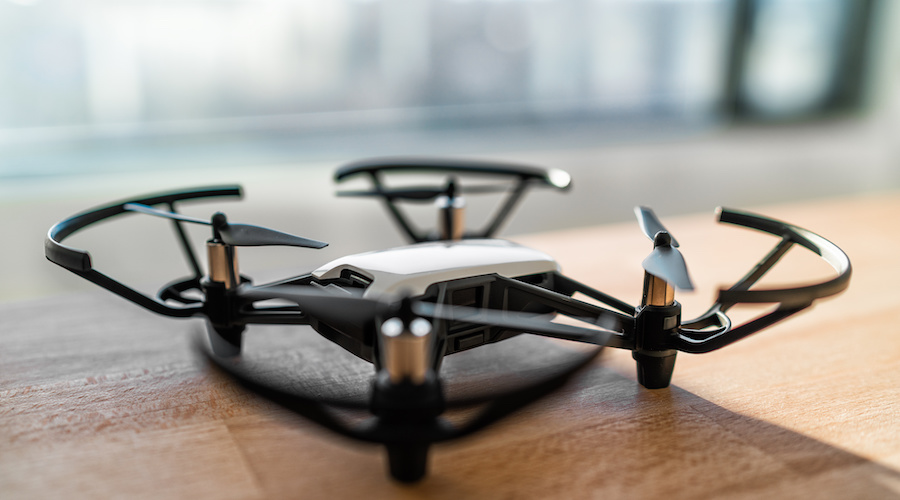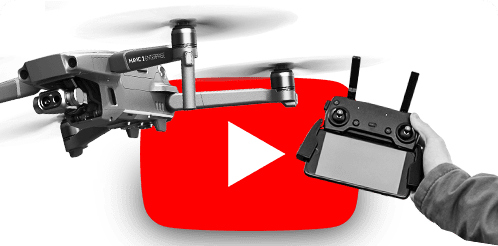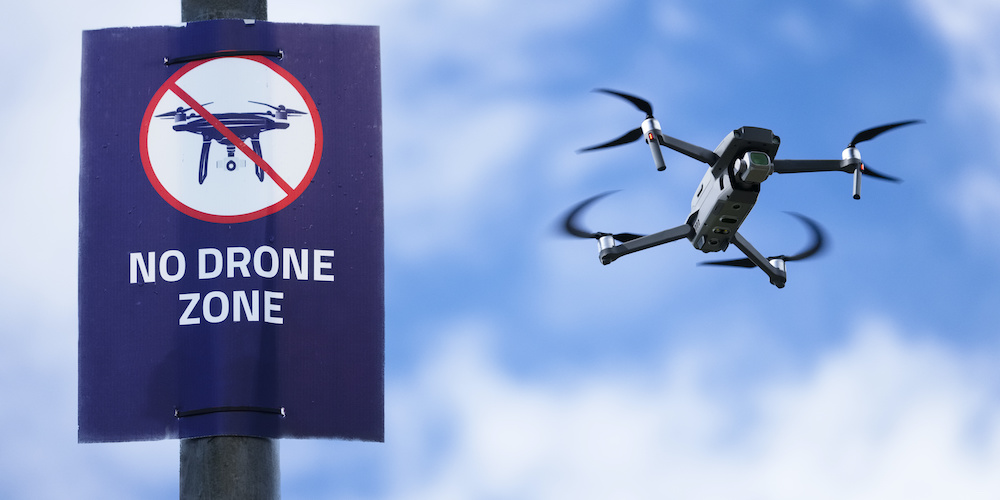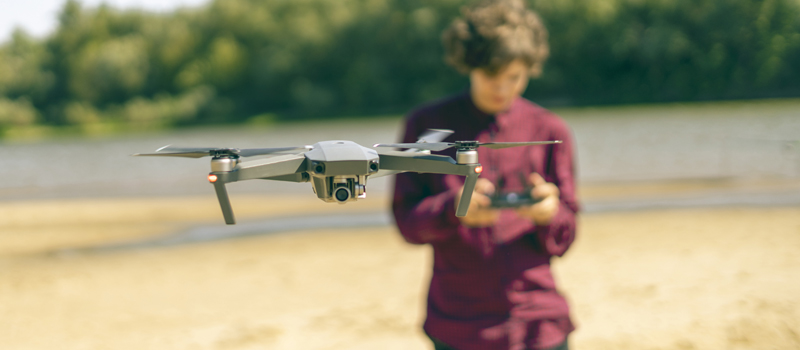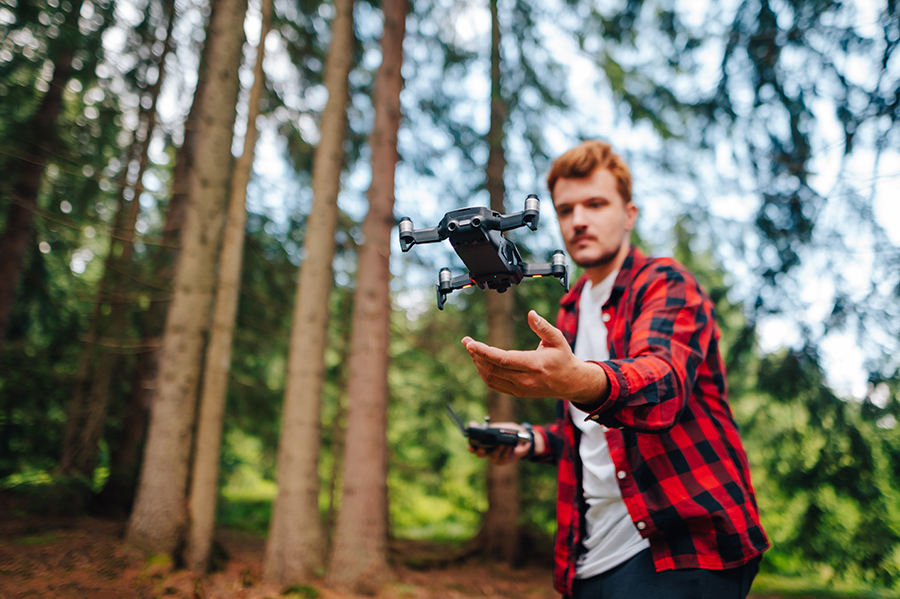-
Why fly your drone indoors?
- 1. Video coverage of indoor events
- 2. Shooting real estate video tours
- 3. Industrial inspection
-
What hazards to expect when flying indoors
- 1. High density of obstacles
- 2. Loss of GPS-aided stabilization
- 3. Loss of obstacle avoidance systems
- 4. Internal drafts
- 5. Magnetic interference
-
Tips on how to fly your drone indoors safely
- 1. Fly an ultra-portable drone
- 2. Practice in ATTI mode
- 3. Fly in Tripod mode
- 4. Install propeller guards
- 5. Remove as many of the obstacles as possible
- 6. Don’t get too close to the ceiling
- 7. Make sure everyone in the room is aware
- 8. Fly with a spotter and/or visual observer
- 9. Disable Return to Home
-
Does the FAA allow indoor drone flight?
- Drone News Update
-
Final thoughts
Anyone who has seen how fast a drone moves would probably have an idea of how difficult it would be to fly it indoors. Flying a drone around in a restricted space full of potential obstacles is something that you can pull of only with an incredible level of skill.
However, the reality is that indoor drone flight may sometimes be necessary. This is especially true for professional drone pilots who may find themselves in jobs that require them to fly indoors. What are the hazards of flying a drone indoors and what can pilots do to avoid them?
Why fly your drone indoors?
Let us preface this discussion by saying that we do not recommend flying your drone indoors unless absolutely necessary. Unless you’re flying a toy drone, indoor flight is a lot more complex than flying outdoors. It’s not something we would do for fun.
That said, we also recognize that there is value in being able to fly a drone indoors, particularly for those who do this for a living.
1. Video coverage of indoor events
For drone pilots who offer on-site photo and video coverage of events, a time may come when some of these events are held indoors. Possible examples of these include dinners, conferences, sports events, and concerts. In most cases, such events will also draw huge crowds. It’s not hard to imagine how heavy the consequences could be if a drone will crash in this setting.
2. Shooting real estate video tours
Real estate advertising has proven to be a solid market for professional drone services. Drones provide a unique perspective of properties for sale, giving clients a more comprehensive look at a property than any photos or videos shot from the ground.
Drones also have the unique capability of shooting videos that can act as virtual tours for the clients. By flying from room to room inside and outside the house, drones can simulate the feeling of movement through the property. Obviously, this takes a lot of skill for the drone pilot not just to avoid crashing but to make sure that the video is as smooth as possible.
3. Industrial inspection
In rare cases, manufacturing facilities may hire drone pilots to aid in the inspection of large industrial equipment. This is a much safer and faster alternative to having their crew work in elevated areas. For a drone pilot to successfully pull off such a job, they will have to be experts at flying in close quarters. This is an advanced skill, especially considering how residual magnetic waves from the equipment can affect communication between the drone and the transmitter.
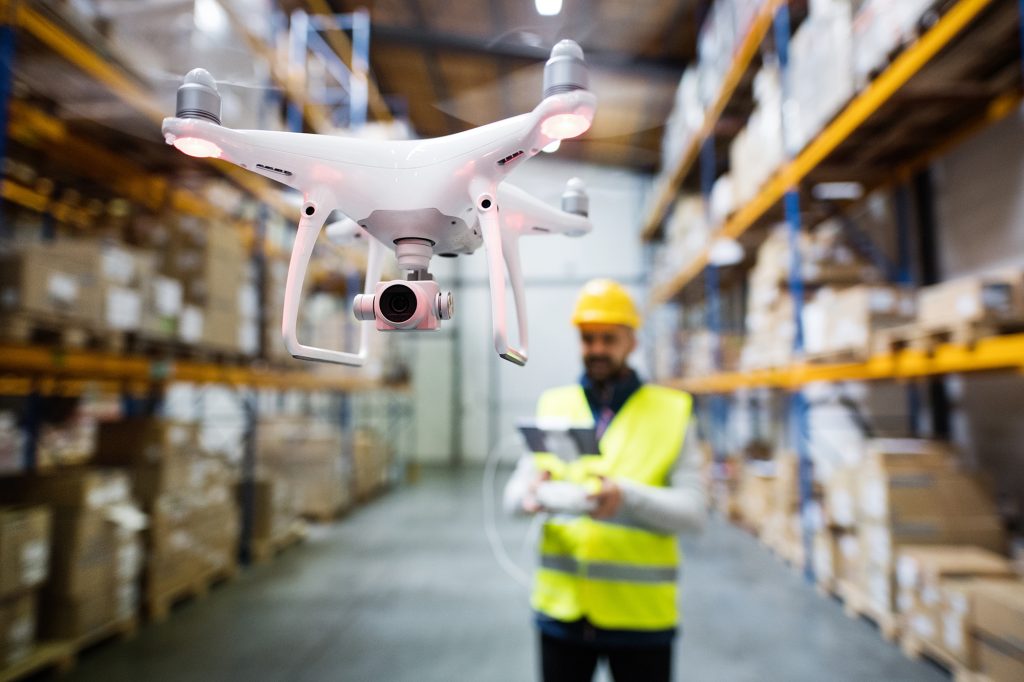
What hazards to expect when flying indoors
Knowing is half the battle. When flying indoors, a drone pilot must be aware of the inherent hazards of such an environment. This list then becomes the basis for the appropriate mitigating measures.
1. High density of obstacles
The most glaring difference between flying indoors and outdoors is the fact that there much more obstacles and surfaces for a drone to crash on in an interior space. There are ceilings, walls, support columns, hanging decors, and lights, just to name a few. A drone pilot who only flies outdoors probably isn’t used to having to pay attention to so many obstacles simultaneously with the drone.
2. Loss of GPS-aided stabilization
Stabilization by GPS is one of the biggest handicaps that drone pilots have gotten used to and often take for granted. This technology allows the drone to hover in place at a fairly permanent position, moving only to offset drifting caused by the wind.
When flying indoors, you would be very lucky to receive any GPS signal. This is a hurdle you will have to anticipate. This means that you will need to control the drone’s movement at every moment – you cannot command it to simply hover in place.
3. Loss of obstacle avoidance systems
Most of the new drones being released today come with some sort of obstacle avoidance technology using either sonar, infrared, or optical sensors. These allow drones to automatically avoid crashes by altering their flight paths or stopping when they predict that they are about to crash into obstacles.
The problem with using an obstacle avoidance system is that it’s likely going to be a crutch than a benefit. The range of these sensors is quite large, so you’ll probably find yourself not being able to move as freely in an indoor space as you’d like. This is problematic if you’re trying to capture smooth videos or framing a shot.
4. Internal drafts
You may not think that drafts would be such a big deal when flying a drone indoors, given that your drone can handle them perfectly well when flying it outside. However, this discounts the fact that you will be flying without GPS stabilization and that the drone itself can create drafts. In an enclosed space, the self-generated drafts of a drone can be enough to knock it off the air. This emphasizes the need to avoid flying near large solid surfaces like walls and ceilings.
5. Magnetic interference
All electrical devices emit some sort of magnetic field, and this can disrupt the signals that are exchanged between your drone and the remote controller. The intensity of such magnetic fields may not be a huge problem if you’re just flying in a house or a conference hall. However, large industrial equipment can emit much stronger magnetic fields. This is something you’ll need to be aware of and prepare for if you’re doing indoor inspection of industrial equipment, given that you’ll have limited space to maneuver.
Tips on how to fly your drone indoors safely
1. Fly an ultra-portable drone
The first safety measure when flying indoors is to not over-reach. It would be tempting to impress a crowd with an Inspire 2 but it would simply be too big to negotiate through the obstacles of an indoor space. By using a small of a drone as possible, you drastically reduce the chances of getting into a crash. Even if you do crash, a small drone will cause much less damage.
Any of the ultra-portable drones that are very popular nowadays would be good options. The Mavic Air is one of the smallest drones to come with a 4K camera, as is the Autel Evo. If you can get away with using even smaller drones, like the Mavic Mini or the Tello, then that’s an option you should consider.
2. Practice in ATTI mode
Most drone models come with an ATTI or “Attitude” mode. In this mode, GPS stabilization is deactivated. This is a good mode to practice in to simulate how it’s going to feel when you eventually fly your drone indoors. As we’ve mentioned, this disables the ability of the drone to “auto-correct” its position when it gets carried away by the wind. Flying in this mode will force you to pay full attention to the drone and to manually offset any unintended movement.
One more thing you’ll need to remember is that drones don’t have an “auto-braking” capability in ATTI mode. If you want your drone to stop moving, you can’t just let go of the analog sticks – you’ll have to shift the sticks in the opposite direction. This is something you’ll have to get used to by practicing.
Some drones may not have modes that allow for GPS deactivation. For these cases, a few drone pilots have taken to wrapping their drones’ GPS receivers with some aluminum foil. This is something you can consider doing as long as it does not compromise your drone’s ability to communicate with your remote controller.
3. Fly in Tripod mode
The last thing you would want is to have your drone flying around at maximum speeds in an enclosed space. Every drone should have a mode that limits its movement speed. This can be called Tripod Mode, Cinematic Mode, or Beginner Mode. The point is that these modes set a lower cap to the speeds that a drone can reach. They can also dampen the response of the drone to the controls, thereby making them move more gently.
4. Install propeller guards
Not all drones have propeller guards. If yours does, it would be prudent to put them on during an indoor flight. This does not need much explanation. A drone’s propellers are its most dangerous components, especially if they come crashing down on people. It’s not uncommon to hear stories of people suffering lacerations from spinning propellers. While propeller guards don’t offer a 100% guarantee that such accidents will be avoided, the small amount of protection they provide can still be helpful.
5. Remove as many of the obstacles as possible
If you’re flying indoors for an event, it would be a good idea to do practice flights in the area before the crowds come in. This gives you a chance to be familiar with the space and to make requests to remove as many of the obstacles in the space as possible.
It’s probably impossible for an internal space to be completely free of obstacles, but it’s worth the effort to get most of them out of the way. This could include banners, loose wires, and hanging ornaments. Of particular concern are fixtures and furniture that could break, such as a piece of hanging light fixture.
If removing the obstacles will ruin the aesthetics of the space, you can instead plan a flight path that your drone can stick to that is somewhat obstacle-free. This might hamper your creative options while doing the job but it’s your safety measure to implement as the drone operator.
6. Don’t get too close to the ceiling
It takes a fundamental understanding of aerodynamics to understand how flying too close to ceilings, walls, and the ground can quickly result in a crash. As the propellers of a drone spin, they slice through the air and push it downward, generating lift. Any disruption to this airflow can cause an unpredictable movement of the drone. This danger becomes even more pronounced with the lack of GPS stabilization.
This isn’t something you would want to experiment with, but a drone flying too close to a ceiling may find itself getting sucked closer to the ceiling. The same phenomenon can happen when flying close to a wall. In either case, the low-pressure zone created by the rotation of the propellers so close to a large surface results in a vacuum. This vacuum then affects the flight direction of the drone.
7. Make sure everyone in the room is aware
Situational awareness is one of the most important tools that a drone pilot must have to avoid accidents. If you’re flying over a crowd, then it’s also your responsibility as a drone pilot to give the people some measure of awareness. Make sure that everyone in the room knows that there’s a drone flying over them so they can respond appropriately if something bad happens.
Fortunately, almost all drones are loud enough to be heard by people on the ground. This is probably even louder in an enclosed space.
8. Fly with a spotter and/or visual observer
Even when flying outdoors, a drone pilot is expected to pay 100% attention to the drone. If this is impossible, then they would have to operate with a visual observer. In any case, it is the responsibility of both the drone pilot and visual observer to keep their eyes on the drone and to scan the surroundings for any potential obstacles.
This task can be a little harder in an indoor space. On top of a higher number of potential obstacles, you’ll also have to contend with the people on the ground who will be naturally curious about what you’re doing. It would be a good idea to have another person on the crew who will be responsible for making sure that you don’t get distracted by these inquisitive people.
9. Disable Return to Home
Activating a drone’s Return to Home (RTH) feature is usually a good idea and something you should double-check if you’re flying outdoors. However, the RTH feature kicking in could be disastrous in an indoor space.
This is because the drone typically gains altitude during RTH, with the intention of steering clear of any obstacles. Obviously, this isn’t going to happen in an indoor space. The likely outcome would be the drone hitting the ceiling and crashing down immediately.
Not having RTH activated means that it’s going to be very important that you keep the communication between the drone and your remote controller stable at all times. This means not letting your drone fly too far away and avoiding any obstacles to come between the drone and the remote controller.
Does the FAA allow indoor drone flight?
With all the safety concerns out of the way, there’s still a concern we need to address: is it even legal to fly a drone indoors?
All drone laws and regulations in the US are created and implemented by the FAA. This is because FAA has the jurisdiction over national airspace, and airspace safety is one of their primary concerns. Thus, the Part 107 rules for professional drone pilots and the pertinent rules for recreational drone pilots under the FAA Reauthorization Act of 2018 are all executed through the authority of the FAA.
However, there’s a glaring exception when it comes to any indoor space – it is not part of national airspace. In fact, any space enclosed by a roof is no longer within the jurisdiction of the FAA. This means that there are no drone-related laws and regulations that can be implemented in an indoor space.
In conclusion, drone flight indoors does not violate any existing laws. This also means that indoor drone flight can be done by both licensed and recreational drone pilots. This is quite ironic, given how much we have emphasized how difficult it is to fly a drone indoors.
Final thoughts
Indoor drone flight is a bit of a taboo in the drone community. Most drone pilots don’t like the idea of it, many of them don’t like doing it, but just about everyone recognizes that there are times when it’s necessary. The dangers of drone flight are magnified in an indoor space because of increased chances of crashing and the potential to cause heavy injury or personal damage.
The main takeaway from this article is that indoor drone flight is difficult and dangerous. It’s something that must be done only when necessary. If you provide professional drone services, you may instead offer safer alternatives such as the use a handheld gimbal camera or a 360-degree camera.
